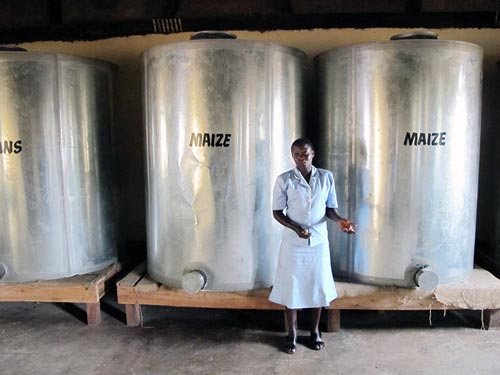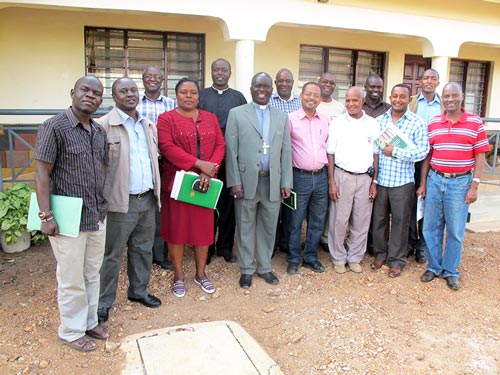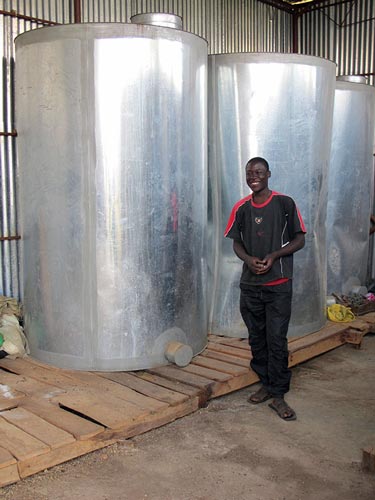 “When Richard Pamo, the then Caritas Development Coordinator [Homa Bay] introduced the metal silo technology to me in 2008, I felt I had received the solution to my perennial problems of storing my grains, particularly maize that was prone to weevil attack,” said Bishop Philip Anyolo of the Catholic Diocese of Homa Bay, Kenya, to a visiting team from the Effective Grain Storage for Sustainable Livelihoods of African Farmers Project (EGSP-II). “I instantly ordered two silos, of 1- and 1.8-ton capacity. And I have never been disappointed. I was so satisfied with the ability of the metal silos to protect my maize against weevils that I acquired another 720-kg capacity metal silo for my mother in 2009.”
“When Richard Pamo, the then Caritas Development Coordinator [Homa Bay] introduced the metal silo technology to me in 2008, I felt I had received the solution to my perennial problems of storing my grains, particularly maize that was prone to weevil attack,” said Bishop Philip Anyolo of the Catholic Diocese of Homa Bay, Kenya, to a visiting team from the Effective Grain Storage for Sustainable Livelihoods of African Farmers Project (EGSP-II). “I instantly ordered two silos, of 1- and 1.8-ton capacity. And I have never been disappointed. I was so satisfied with the ability of the metal silos to protect my maize against weevils that I acquired another 720-kg capacity metal silo for my mother in 2009.”
The Bishop, who was among the first people to use metal silos after the project introduction in Kenya, noted how widely appreciated the technology has become: “Since I acquired the metal silos, word about its effectiveness has spread within and beyond my home county of Bungoma, which was not even in the project target area. Like in Homa Bay, farmers there are making all efforts to acquire the metal silos.” And it is not just the farmers who use the technology these days; Rose Owanda in the poultry business has acquired six 2.7-ton capacity metal silos. “I intend to be buying grains from the market during times of glut. This will not only ensure that I buy the grains at the lowest prices, I am assured of enough grain for making the feeds for the birds throughout the year.” The success of the silo has also created brisk business for trained metal silo artisans who are receiving orders from beyond the Homa Bay County.
 Impressed with the technology, the Bishop has advised all schools and institutions sponsored by the Catholic Church in Homa Bay to acquire metal silos for grain storage. His advice has since caught the attention of other institutions, including St. Vincent De Paul Boys Boarding School in Kisii County who acquired seven 2.7-ton metal silos in December 2011 after the Nyambururu Teachers College, Kisii County, bought ten 1.8-ton silos earlier in the year; the College had learned of the technology from the Kokwaro Secondary School in Homa Bay Diocese who had acquired eight 2.7-ton silos in 2010. Since the launch of EGSP-II in October 2012 in Kenya, Homa Bay farmers have acquired 230 metal silos, and institutions in the area, particularly boarding schools and colleges, have bought 47 more, according to Beautrice Otieno, Livelihoods Program Manager at Caritas Homa Bay and the site coordinator for western Kenya.
Impressed with the technology, the Bishop has advised all schools and institutions sponsored by the Catholic Church in Homa Bay to acquire metal silos for grain storage. His advice has since caught the attention of other institutions, including St. Vincent De Paul Boys Boarding School in Kisii County who acquired seven 2.7-ton metal silos in December 2011 after the Nyambururu Teachers College, Kisii County, bought ten 1.8-ton silos earlier in the year; the College had learned of the technology from the Kokwaro Secondary School in Homa Bay Diocese who had acquired eight 2.7-ton silos in 2010. Since the launch of EGSP-II in October 2012 in Kenya, Homa Bay farmers have acquired 230 metal silos, and institutions in the area, particularly boarding schools and colleges, have bought 47 more, according to Beautrice Otieno, Livelihoods Program Manager at Caritas Homa Bay and the site coordinator for western Kenya.
 “Production is all in vain if farmers cannot store the harvested produce. Effective storage is even more critical at these times of climate change, where the associated weather vagaries adversely affect production. Whatever little that we produce should be well managed, and that includes being well stored for use at the desired time,” stressed Jennifer Ndege, Chief Officer, Agriculture, Livestock and Fisheries at Homa Bay County. Tadele Tefera, CIMMYT entomologist and EGSP-II coordinator, agrees: “A lot of agencies focus on increasing productivity but very few on the management of what has been harvested. Yet this is a very important aspect in any food security chain.” The information was collected during an assessment tour of Homa Bay and surrounding counties conducted by the EGSP-II Kenyan team during 15-19 July 2013; the team consisted of Tefera, Isaac Mutabai (CIMMYT), Wandera Ojanji (CIMMYT science writer/editor), Zachary Gitonga (CIMMYT Socioeconomics Program research associate), Addis Teshome (CIMMYT entomologist), Jackson K. Njana (Caritas-Embu), Everastus Okumu (Caritas-Homa Bay director), Otieno, Paddy Likhayo (Kenya Agricultural Research Institute, KARI), and Kimondo Mutambuki (KARI and EGSP-II Kenya national coordinator).
“Production is all in vain if farmers cannot store the harvested produce. Effective storage is even more critical at these times of climate change, where the associated weather vagaries adversely affect production. Whatever little that we produce should be well managed, and that includes being well stored for use at the desired time,” stressed Jennifer Ndege, Chief Officer, Agriculture, Livestock and Fisheries at Homa Bay County. Tadele Tefera, CIMMYT entomologist and EGSP-II coordinator, agrees: “A lot of agencies focus on increasing productivity but very few on the management of what has been harvested. Yet this is a very important aspect in any food security chain.” The information was collected during an assessment tour of Homa Bay and surrounding counties conducted by the EGSP-II Kenyan team during 15-19 July 2013; the team consisted of Tefera, Isaac Mutabai (CIMMYT), Wandera Ojanji (CIMMYT science writer/editor), Zachary Gitonga (CIMMYT Socioeconomics Program research associate), Addis Teshome (CIMMYT entomologist), Jackson K. Njana (Caritas-Embu), Everastus Okumu (Caritas-Homa Bay director), Otieno, Paddy Likhayo (Kenya Agricultural Research Institute, KARI), and Kimondo Mutambuki (KARI and EGSP-II Kenya national coordinator).
 Climate adaptation and mitigation
Climate adaptation and mitigation 
